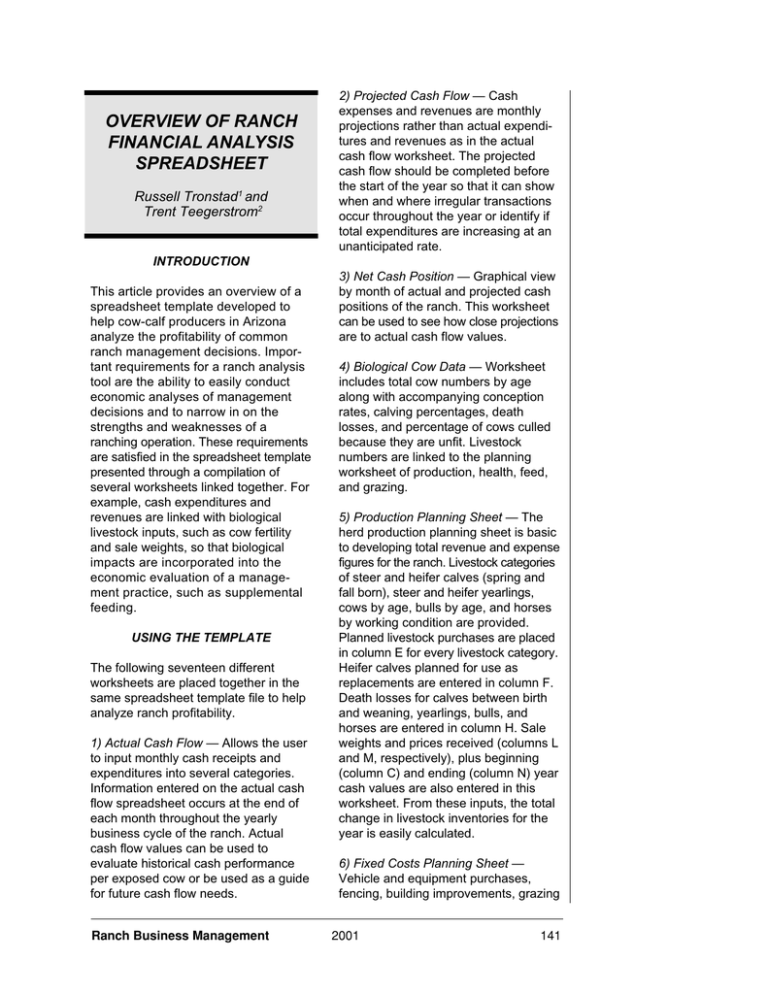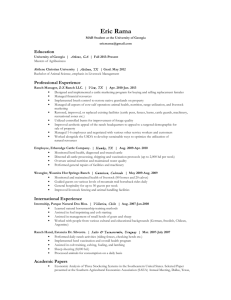expenses and revenues are monthly projections rather than actual expendi-
advertisement

OVERVIEW OF RANCH FINANCIAL ANALYSIS SPREADSHEET Russell Tronstad1 and Trent Teegerstrom2 2) Projected Cash Flow — Cash expenses and revenues are monthly projections rather than actual expenditures and revenues as in the actual cash flow worksheet. The projected cash flow should be completed before the start of the year so that it can show when and where irregular transactions occur throughout the year or identify if total expenditures are increasing at an unanticipated rate. INTRODUCTION This article provides an overview of a spreadsheet template developed to help cow-calf producers in Arizona analyze the profitability of common ranch management decisions. Important requirements for a ranch analysis tool are the ability to easily conduct economic analyses of management decisions and to narrow in on the strengths and weaknesses of a ranching operation. These requirements are satisfied in the spreadsheet template presented through a compilation of several worksheets linked together. For example, cash expenditures and revenues are linked with biological livestock inputs, such as cow fertility and sale weights, so that biological impacts are incorporated into the economic evaluation of a management practice, such as supplemental feeding. USING THE TEMPLATE The following seventeen different worksheets are placed together in the same spreadsheet template file to help analyze ranch profitability. 1) Actual Cash Flow — Allows the user to input monthly cash receipts and expenditures into several categories. Information entered on the actual cash flow spreadsheet occurs at the end of each month throughout the yearly business cycle of the ranch. Actual cash flow values can be used to evaluate historical cash performance per exposed cow or be used as a guide for future cash flow needs. Ranch Business Management 3) Net Cash Position — Graphical view by month of actual and projected cash positions of the ranch. This worksheet can be used to see how close projections are to actual cash flow values. 4) Biological Cow Data — Worksheet includes total cow numbers by age along with accompanying conception rates, calving percentages, death losses, and percentage of cows culled because they are unfit. Livestock numbers are linked to the planning worksheet of production, health, feed, and grazing. 5) Production Planning Sheet — The herd production planning sheet is basic to developing total revenue and expense figures for the ranch. Livestock categories of steer and heifer calves (spring and fall born), steer and heifer yearlings, cows by age, bulls by age, and horses by working condition are provided. Planned livestock purchases are placed in column E for every livestock category. Heifer calves planned for use as replacements are entered in column F. Death losses for calves between birth and weaning, yearlings, bulls, and horses are entered in column H. Sale weights and prices received (columns L and M, respectively), plus beginning (column C) and ending (column N) year cash values are also entered in this worksheet. From these inputs, the total change in livestock inventories for the year is easily calculated. 6) Fixed Costs Planning Sheet — Vehicle and equipment purchases, fencing, building improvements, grazing 2001 141 Figure 1. Control Sheet Headings and Decision Control Cell Decision Control cell (type 1 in cell H4) for activating planning sheets. Tabs below indicate that the worksheet of "Control Sheet" is selected. resources, and other related nonlivestock asset costs are entered in this worksheet. This sheet calculates annual payments and depreciation (straightline) utilizing purchase price, estimated useful life, salvage value, down payment, interest rate, and loan term (years) values. Other values entered include the beginning and ending year cash value of the asset. Cash values are used to determine changes in owner’s equity. 7) Control Sheet — This sheet is a control sheet for determining whether cash flow values (actual shown in column G or modified as entered in column E of Figure 1) or values associated with all planning sheets feed into the diagnostic worksheets. A value of 1 entered in cell H4 activates values from all planning sheets associated with livestock inventories and fixed asset information to be transferred to the ranch diagnostic and financial sheets. Ranch Business Management Note that a value of 1 is placed next to all items in column H that trigger a value to be called from the planning sheet. Values from planning sheets link to column I of the Control Sheet so that year-to-date cash values, projected cash values, and projected totals from the planning sheet can be seen sideby-side. A value other than 1, say 0 in cell H4, will reflect just cash transaction values in the ranch diagnostic and financial sheets. See Figure 3 for a graphical snapshot of how all the sheets link together and note that the Control Sheet is a flow control sheet. Note that throughout all of the worksheets, user input can be provided whenever a cell is shaded inside a line-box—otherwise values are automatically calculated from prior input. 8) Cost & Returns — This report gives a legend summary of total and per unit cash receipts and expenditures by major category. Returns after cash 2001 142 outlays, returns after inventory changes, and returns to unpaid labor, management, and risk are provided. Break-even steer prices ($/cwt.) for each cwt. of steer calf sold are also provided at each level. Note that only gross income less the cash outlay calculations are valid unless cell H4 in the Control Sheet equals 1 or “planning sheets” are in use. 9) Total Diagnostic Tree — Total cash and accrual profit values are decomposed into the general areas of gross sales (calves, yearlings, cows, bulls, and horses), cash production costs, cash overhead costs, depreciation, adjusted cash value of fixed assets, and livestock adjusted inventory income. Note that the accrual profit value is relevant only if the planning sheets are utilized (i.e., cell H4 in the Control Sheet equals 1). This sheet can be used as a visual snapshot to identify critical areas of ranch management depending on how large the expenses and revenues by general category are for the ranch. A management change of building a new tank that increases the grazing capacity of the ranch by 5 AUYs can be easily analyzed from this sheet. 10) Diagnostic Tree Per Exposed Cow — This sheet takes the information from the total diagnostic tree worksheet and displays it on a per exposed cow basis. This sheet has great value for comparing expenditure and revenue performance across categories for different ranches. Management decisions such as creep feeding calves can be easily evaluated from this sheet, while focusing on the final cash and accrual profit per exposed cow. Creep feeding will directly increase labor and feed costs, but it will also impact weaning weights and sale prices. How all of these factors fit together can be easily evaluated by looking at the final cash and accrual profit values per exposed cow in this sheet. 11) Finance Measures — Common financial measures such as current Ranch Business Management assets and liabilities and owner’s equity are reported in this sheet. Financial ratios associated with liquidity and solvency are also presented. 12) Health Expense Planning Sheet — Veterinary expenses associated with pregnancy testing, bull testing, vaccinations, and implants can be itemized out in this sheet for all livestock given in the production planning sheet. 13) Feed Expense Planning Sheet — Cost of supplement, minerals, salt, and hay is calculated from the inputs of cost of the feed ($/ton), pounds of feeding per day, and the number of days on feed. Livestock numbers provided in the production planning sheet are also linked to calculate total feed costs. 14) Grazing Planning Sheet — This sheet is tailored for public grazing fees of Bureau of Land Management, U.S. Forest Service, and State land. Grazing fees for these agencies are generally different, so the number of grazing months for each class of livestock on these different lands, along with any Animal Unit Month (AUM) conversion is required to calculate total grazing costs. Private grazing months and costs should also be included, if applicable. Grazing costs associated with land that is owned comes from the fixed cost planning sheet. 15) Labor Expense Planning Sheet — Hired labor associated with a manager, a bookkeeper, or cowboys is easily input into the labor expenses of the ranch using this sheet. Benefits such as FICA, Workman’s Compensation, or other benefits can be easily calculated in this sheet to determine total labor costs. 16) Actual Cash Flow Charts — Several figures display total cash income and expenses, operating receipts, variable costs, and overhead costs by major category and month. These charts display values from the actual and projected cash flow worksheets. 2001 143 Figure 2. Key Output Associated with Retained Ownership Worksheet 17) Retained-Own Evaluation Sheet — Retained ownership is considered a separate enterprise from the ranch, so this worksheet is not linked to any of the other worksheets given above. This sheet provides the expected return from retained ownership, utilizing future market data available for when animals would be placed in the feedlot. Five different initial feeder weights (i.e., 400, 500, 600, 700, and 800 pounds) are evaluated side by side for five different “purchase dates” or days for entering the feedlot. Most current futures prices (all time horizons), along with expected basis values (cash minus futures) need to be entered. Figure 2 shows some of the key output values, such as: expected profit per head (columns AJ and AM) and annual adjusted percentage rate (columns AK and AN); feed (column AD) and total cost of gain (column AF); and break-even price for purchasing feeders (columns AP and AR). A total of 25 different purchase date and weight combinations are provided. Purchase date and weight combinations that are too far into the future for a feeder to be sold using the Ranch Business Management fed futures when purchased are displayed with “######”. Figure 3 displays how all the worksheets described above fit together. Four general categories of information are: 1) cash expenditures and revenues (e.g., calf sales, checkbook transactions); 2) biological livestock data (e.g., sale weights, cow fertility, cull rates, death losses); 3) livestock inventory values (e.g., head counts, cash values); and 4) fixed asset information (e.g., land, equipment depreciation, cash and book values). Figure 3 describes how these general categories of information flow from one worksheet to the next. Note that planning sheets must be in use (i.e., cell H4 in the Control Sheet equals 1) for any accrual values associated with livestock inventory or fixed asset information to feed forward into financial measures, costs and returns, and diagnostic tree worksheets. The spreadsheet template is available from the authors for free, but you still need to input your baseline data. After 2001 144 Figure 3. Flow Diagram of Excel Ranch Analysis Workbook Symbols Indicate the Type of Information Included in Each Worksheet ✩ ❅ ❒ ❖ ----- Cash Expenditures & Revenues (e.g., calf sales, checkbook transactions) Biological Livestock Data (e.g., sale weights, cow fertility, cull rates, death losses) Livestock Inventories (e.g., number cows (by age), calves, and yearlings) Fixed Asset Information (e.g., land, equipment depreciation, cash & book values) Planning/Accrual Analysis Cash Analysis (control=1) (control≠1) Control Sheet Actual Cash Flow ✩ Net Cash Position Chart ✩ Projected Cash Flow ✩ control ≠ 1 (cash flow) ✩ enterprise from Ranch) ✩ ✩❒ ✩❅❒❖ Feed Planning Sheet Fixed Costs Planning Sheet ✩❒ ✩❖ Diagnostic Trees Cash Accrual Profit Profit entering data from your ranch, you can evaluate your operation using the diagnostic trees and see where you should target changes in your management. Management decisions can be easily evaluated once you have entered your baseline data. For example, if you are considering supplemental feeding as a way of increasing calving rates, you could enter the proposed feeding schedule into the feed expense planning spreadsheet and change the calving rates in the biological cow data spreadsheet. A quick look at either the diagnostic tree per exposed cow or the cost and return worksheet would display the estimated impact on expected profits. Other potential management plans could be evaluated in a similar fashion. Once a plan has been selected and implemented, it must be monitored. This includes physical aspects, such as calving rates, as well as economic aspects, such as expenses and market prices. When differences occur between the plan and reality, it is time to evaluate ✩❅❒❖ ❅ Health Expense Planning Sheet Cost and Returns Accrual Cash ✩ Ranch Business Management Biological Cow Data ✩❅ ❒ ✩❅❒ Retained Ownership Planning Sheet (separate Production Planning Sheet control =1 (planning) Grazing Planning Sheet Finance Measures ✩❒ ✩❅❒❖ Labor Planning Sheet ✩❒ the reasons for the differences and possibly develop a revised management plan. At this point, the spreadsheet template presented can again be used as a tool to assist in the planning process. CONCLUSIONS Although spreadsheets are not structured to capture all the dynamics that can be associated with management decisions, they are relatively easy to follow and understand. Once a spreadsheet template is developed, it can easily be modified and tailored to a specific situation. Another advantage of using spreadsheets for planning is that you may get new ideas about management strategies by going through the planning process. 1 Associate Extension Specialist, Agricultural and Resource Economics, The University of Arizona 2 Research Specialist, Agricultural and Resource Economics, The University of Arizona 2001 145 FROM: Arizona Ranchers’ Management Guide Russell Tronstad, George Ruyle, and Jim Sprinkle, Editors. Arizona Cooperative Extension Disclaimer Neither the issuing individual, originating unit, Arizona Cooperative Extension, nor the Arizona Board of Regents warrant or guarantee the use or results of this publication issued by Arizona Cooperative Extension and its cooperating Departments and Offices. Any products, services, or organizations that are mentioned, shown, or indirectly implied in this publication do not imply endorsement by The University of Arizona. Issued in furtherance of Cooperative Extension work, acts of May 8 and June 30, 1914, in cooperation with the U.S. Department of Agriculture, James Christenson, Director, Cooperative Extension, College of Agriculture and Life Sciences, The University of Arizona. The University of Arizona College of Agriculture and Life Sciences is an Equal Opportunity employer authorized to provide research, educational information, and other services only to individuals and institutions that function without regard to sex, race, religion, color, national origin, age, Vietnam Era Veteran’s status, or handicapping conditions. Ranch Business Management 2001 146




